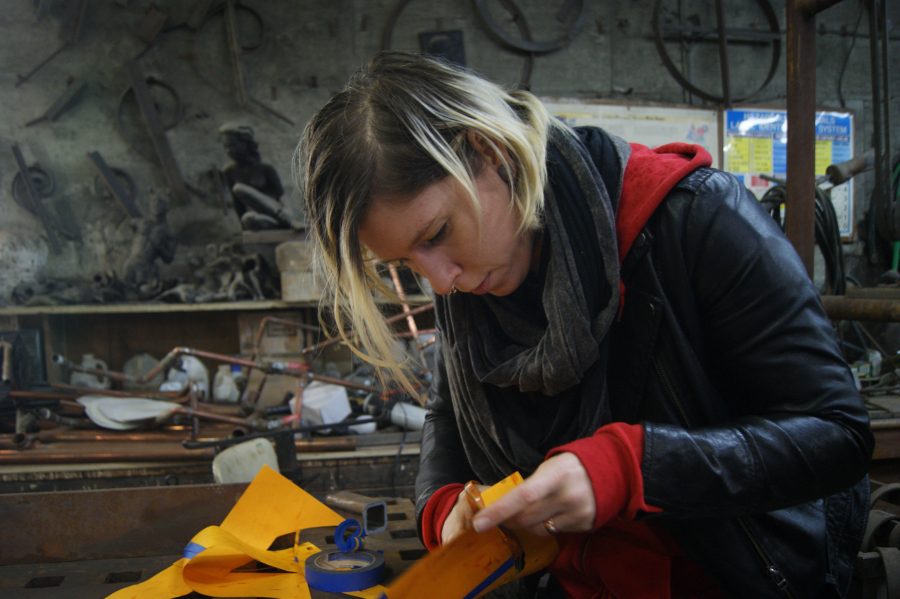Seattle mobilizes for Standing Rock
December 5, 2016
A man stands before me, belly filling out his faded and grease-stained red hoodie. As he turns around to greet me, the white and brown flecks of his mustache widen with a grin.
“You here for Standing Rock?” he asks as he reaches out to shake my hand.
I notice the thick callouses on his palms as I reply that I am a student from Edmonds Community College, coming with tools borrowed from the engineering department to lend a hand.
He starts describing the process to me: “Three-inch measurements from the bottom rim, holes drilled here, here and here,” and then must have noticed my eyes starting to glaze over.
Matt stopped and smiled again. “We’re just building stoves. It’s not rocket science.”
Matt runs a little hole-in-the-wall metal shop just off of Westlake Ave in Fremont.
Hastily scrawled graffiti fades above the barred gate door, which practically opens up right onto the busy street.
Inside, long fluorescent lights illuminate peeling, painted brick walls and tables and shelves cluttered with an eclectic mixture of countless items.
Delicately sculpted busts lie next to copper pipes, anvils, metal scraps, plastic jugs and unfinished projects in a room dominated by a massive ‘power hammer,’ a huge 12-foot-tall machine he picked up in Concrete, Wash., that is capable of slamming a 200-pound weight twice a second.
But as volunteers begin to file in our conversation ends. We are here for a reason – to support the individuals in North Dakota who are protesting the construction of the Dakota Access Pipeline (DAPL), which is planned to run underneath Lake Oahe upstream of the Standing Rock Sioux reservation.
This path runs the risk of contaminating the water supply of the reservation and that of the millions of people who live downstream on the Missouri River.
For many, the protests represent much more than water rights. For some, it is a protest about our society’s reckless addiction to carbon fuels. Others see it as a stand against political corruption.
President-elect Donald Trump has investments running between $1 million and $2 million dollars in Energy Transfer Partners, the operators of the DAPL pipeline, and other companies with significant shares in the project.
For the Sioux and other First Nations peoples across the country it has come to embody the struggle to retain their land and culture that has continued unabated for hundreds of years.
The protests have struck a chord. With more than 12,000 people now on the ground in North Dakota, representing more than 200 indigenous tribes, the need for adequate shelter is great.
This is where we come in.
Volunteers have come from all over Seattle and the surrounding area to congregate at Matt’s shop following the vision of one man – Paul Cheoketen Wagner. After spending time in the frigid conditions at the protests he realized the critical need for shelter.
Wagner began designing and crowdfunding simple insulated teepees made from materials easily located at any hardware store.
The wood-burning furnaces we are building are the final, crucial step in the production of these shelters that will protect up to 720 individuals from the harsh cold of the North Dakota winter.
Stepping onto the street, a cool breeze blows as cars rush by on busy Westlake.
A small crowd is now gathered around a bespectacled man who leans over one of the 55 gallon metal drums, marker and ruler in hand.
Carefully, he marks the exact orientation of each cut and hole to be drilled, and the crowd sets off to work replicating his measurements.
Outside the crew marks and prepares the drums, while inside we begin turning them into furnaces. The long dark hair of my partner, Poy, falls alongside his shoulders as he leans into his drill, the screech of the metal parting as he pushes into the drum.
We are an unbroken, cacophonous chain – outside the crew marks up the furnaces-to-be, inside Poy and I drill and enlarge the holes, passing the barrels off to Steve with his circular saw and Matt who finally torches them.
The noise is intense, the scene one of controlled chaos, and people whirr by in frantic motion until well after dark.
The sound of drills and plasma torches continues unabated. People come and go, like the ebb and flow of the tides.
Ladies show up with armfuls of snacks for us, supplies for the protesters. A pot of chili cools on the table, but we are all too busy to stop and eat. A hugely bearded man laboriously delivers the last of a shipment of steel plates.
From the relative tranquility of Matt’s side office, Poy and I enjoy a moment’s peace. He smiles at me in the shaded room, the wrinkles on his worn face lighting up.
“I thought I’d take a break. Almost too many worker bees,” Poy says. “Besides, I thought I’d let the girls have their turn with the drill.”
By the end of the night, stacks of furnaces line the walls of the shop, reflecting off the bright fluorescent lights.
Five hours of work, upwards of twenty volunteers, and now 22 furnaces ready to be loaded up and sent to North Dakota.
With laughter and warm embraces we exchange contact information, pack up and head home, hope and determination in our hearts.
There is still much work to be done.

